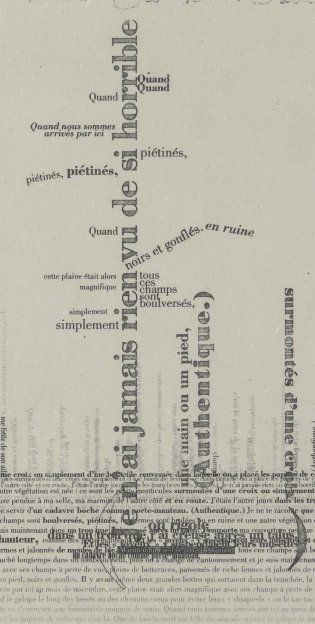L'encre des tranchées
Year: 2001
Artist: Pierre Walusinski (*1980)
Publisher: Pierre Walusinski, Paris
A wreckage of words
In 2001, with L’encre des tranchées (The ink of the trenches), Pierre Walusinski created a complex book on the soldiers who fought in the trenches during the First World War. The texts come from letters written by soldiers that were sent to the home front, some of which were written prior to execution by those accused of having been traitors whilst others were from servicemen detained as German prisoners of war; some of the letter writers died in the trenches but others survived the war. All had borne witness to the hell of The Great War.
The texts were set by hand in Bodoni and printed in letterpress, run off in several layers. The images and a portion of the text were produced as photogravures or in the form of etchings and they, too, were superimposed. The photogravures were produced by Hélio in Issy-les-Moulineux, but the texts were printed on the École Estienne presses in Paris. It comprised a print run of thirty copies, 10 of which were designated for the École. The many print layers and the complex combination of techniques – the embossing in the colophon included – obviously also served to demonstrate just how much the pupil had learnt from his teachers.
A letter from Michel Taupiac
One of the letters was written by Michel Taupiac, a farmer’s son who was mobilized at the age of nineteen. He survived the war and became a fisherman. His letter, dated 14th February 1915, was addressed to an old friend, Justin Cayrou. He wrote: ‘When we arrived here in November the fields were magnificent. Fields of sugar beet as far as the eye could see with, here and there, large farmsteads and rows of haystacks. Now it is the land of the dead.’
Part of this letter excerpt is reproduced on the left-hand side of the page. It then carries on below extending from the left to the right-hand margin of the page. Line for line it continues in that way moving down the page but gradually the letters become less heavily inked in and slowly illegible. The letter excerpt changes into a landscape with a wide horizon above which vertically and crosswise more words are printed: they are letter passages that have been made to look like dead, bare trees, the branches of which are composed of single words and phrases. The syntax has been disrupted.
The texts of the letters have been interpreted with much the same degree of freedom that a composer might exercise in relation to a libretto. The word ‘Quand’ (when) has, for instance, been repeated several times whilst it only features once in the original letter. Just as in an aria, it forms a one-word sequence at the top of the ‘tree’, together with the line: ‘I have never before witnessed such a horrible sight’. The upper ‘branches’ are formed from the word ‘Quand’ in different styles of type so that in reiterating ‘then, then, then’ it almost seems as if the terrors of war make the very narrative itself falter.
A letter from René Jacob
Another letter – the book contains seven in total – was written by René Jacob, a baker, who died in Verdun in 1916 leaving behind a wife and three children. His letter tells of how the troops approached the war zone and of how, ‘suddenly, like the opening of a theatre curtain, the battlefield came into view in all its horror’. The backdrop to this letter is an etching with dark blackened swirls framing the page’s periphery; the middle ground is shrouded in a grey mist. Rising from the bottom of the page – from a wreckage of words one might almost say – certain of the words and sentences jut out like stockades. Jacob wrote that he ‘would never forget’ the sight of the ruins, the poverty and the destroyed and ransacked houses. Indeed, he was not even granted the time to live to remember.
Bibliographical description
Beschrijving: L'encre des tranchées : correspondances / [composé par Pierre Walusinski]. – [Paris]: Walusinski, 2001. – [18] p. in 9 cahiers. : ill. ; 24x45 cm. Drukkers: Pierre Walusinski (L’École Estienne, Parijs) en Hélio (Issy-les-Moulineux)
Typeface: Bodoni
Edition: 15 copies
This copy: Number 7 of 15 on Rives BFK grey paper, numbered and signed by the artist
Note: Collection of seven letters taken from Paroles de Poilus. Paris, Librio, 1998
Shelfmark: KW KOOPM E 68
References
- Paul van Capelleveen, 'Pierre Walusinski', in: Paul van Capelleveen, Artists & Others. The imaginative French book in the 21st century. Koopman Collection, National Library of the Netherlands. Nijmegen, Vantilt Publishers, 2016, p. 78-83
- Paul van Capelleveen, 'Pierre Walusinski', in: Materialia Lumina. Contemporary Artists’ Books from the CODEX International Book Fair. Berkeley, CA: The CODEX Foundation; Stanford: Stanford Libraries, Stanford University, 2022, p. 74-78
- Lydia Harambourg, ‘Typographie, édition, librairie: une passion unique. Entretien avec Pierre Walusinksi, directeur de la librairie Nicaise à Paris’, in: La lettre. Académie des Beaux-Arts, 77 (hiver 2014-2015), p. 28-29
- Pierre Walusinski, ‘Le témoignage de Pierre Walusinksi. Apprendre la gravure typographique aujourd’hui’, in: Art & métiers du livre, 245 (décembre 2004-janvier 2005), p. 71
- Pierre Walusinski, ‘Pierre Walusinski’, in: Atelier de gravure, 23 témoignages. Paris, Ecole Estienne, 2010, p. 59-60




